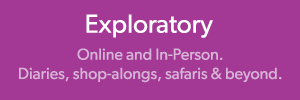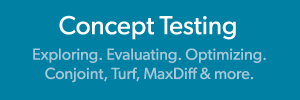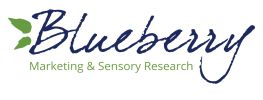Blueberry
“Agile” has become a popular buzzword in research and product development. While an agile process has advantages, namely its speed, creating a truly agile environment can have far-reaching impact across an organization. That’s why it is important to take a step back and first consider exactly what your team needs in a research process and methodology to be successful. Are there ways to achieve faster innovation and other agile benefits without completely disrupting your current workflow? Yes! Here’s how.
An Overview of the Agile Process
An agile process is an intentional, iterative approach to product development and project management with roots in IT and software development. Within an agile environment, each part of a project builds on the next in a series of feedback loops. It begins with exploring, then testing, validating, and optimizing before feeding into the next phase of development with additional exploration, testing, validation, and optimizations until the project is complete.

The goal of an agile environment is to be responsive to shifts as they occur, rather than reactive to changes afterwards. As such, agile research depends on a high degree of transparent contact and efficient collaboration from a cross-functional team. The team itself has the power to make decisions rather than involving upper management in day-to-day activities which tends to slow the project process. The team must be flexible, adaptable, and willing to respond to what is learned along the way, changing their trajectory as new findings are uncovered. A high degree of trust is needed both within the team itself, and between the team and management above it. However, common challenges to this approach include:
-
- The time commitment and attention needed for a single project
-
- Willingness of upper management to step back in decision-making
-
- Organizational and cross-functional buy-in on what may be a radically different way of working
The Importance of Focus
In our experience working within the agile processes of various organizations, we have learned that the key to project success lies in the amount of focus a team is able to place on the task at hand due to the structure and time intensiveness required in this approach. For example, frequent, perhaps even daily, touchpoints keep everyone focused in the same direction – allowing the team to quickly relay and respond to changes as they occur.
That’s why prioritization of a team’s time and resources is so crucial to the agile process in general – underscoring the importance of focus for a research project to be successful. However, a focused approach to research isn’t exclusive to an agile environment. Focus is a common driver of any speed-centric research approach.
Achieving Fast, Focused Research Outside of Agile
Whether your organization is ready to support an agile environment, or you simply want to increase the speed of your research, Blueberry is experienced in delivering fast, focused insights from a customized approach. In fact, there are a number of tools we can leverage to speed up the research process in fielding and execution across both qualitative and quantitative methods.
To learn more about how we can help you innovate faster within an agile environment, or with similar benefits and success outside of one, contact Blueberry today.
Historically, sensory research has been conducted in person. But, as we’ve all learned the hard way over the last year and a half, sometimes circumstances beyond our control ultimately force change. While the pandemic necessitated a move to online methods for marketing research in general, this transition has been particularly difficult for sensory research. It’s certainly been a learning experience for many; however, we believe the change has also created an opportunity to explore the rich insights that can be obtained through virtual methods, not to mention the convenience and flexibility it can provide. Here’s how to ease your transition to online and why your moderator may be your biggest ally in the process.
Sensory Research Then and Now
Pre-COVID-19, it just made sense to conduct sensory research in person, especially for complex projects in which a range of stimuli required testing in a controlled environment. Product labs where consumers would come to a central location were the norm. Now having consumers handling the same stimuli and being in close quarters for extended periods of time is just not possible due to current safety protocols.
What many clients don’t realize, however, is that while conducting sensory research online wasn’t necessarily common before the pandemic, it’s not new for researchers like us. Online tools and techniques have been a great resource for years; the key is that your sensory research team knows how to achieve the same level of quality and rich insights in this digital environment.
Moderating Sensory Research Online
Some of the key challenges in conducting sensory research online are in knowing which online tools will best support the methodology, navigating the level of control required, and making sure the consumer can articulate their sensory experience with the same depth and detail they would in-person.
Having a moderator with sensory experience can be incredibly beneficial here in:
- Choosing the best methodology – As the methodology used will have different implications online, a moderator with both sensory expertise and an awareness of different online tools and techniques will be best suited in designing the research to meet your unique objectives.
- Determining level of control or freedom – With an online method, we are able to dictate the parameters of any product testing. For example, is it most important to control the situation in an at-home usage test or are we more interested in getting feedback on how a consumer naturally uses a product?
- Articulating the experience at a sensory level – There are nuances and a lexicon in the sensory world that make it different than other type of research. Your moderator’s understanding of those differences not only allows them to pivot easily in an online environment, but can also help them take your research from nice-to-know findings to actionable insights.
Benefits of Sensory Research Online
As clients move sensory research online, they’re finding their research is not only just as successful, but that there are also a number of unexpected benefits as well.
First, being in someone’s home via video chat – instead of hovering over them in person – can give you a context that’s incredibly powerful. Respondents simply feel more comfortable in their own space and as such, you may learn even more. And now that video chatting with friends and family is more common than ever, people of all ages are becoming increasingly more familiar with this way of communicating.
Next, there’s a convenience and flexibility to conducting sensory research online. Neither the research team nor the consumers have to worry about the logistics of travel. Plus it’s easier for consumers to participate remotely and fit in the research around their schedule. Not to mention, it’s a safer environment given the ongoing pandemic and eliminates the distraction and challenges of in-person methods due to mask-wearing during the sessions.
But to benefit fully, it’s essential that you work with a moderator backed by a solid team that’s experienced in conducting sensory research online. Our experience ranges from early stage exploratory to pre- or post-launch testing and we’ve spent years vetting platforms and solidifying partnerships that we can leverage for any technology aspects we don’t handle in house. All that combined with the strength of our operational efficiencies makes us a valuable partner in both fielding virtual studies that run smoothly while also obtaining the rich detail and depth required to meet the needs of our clients.
To learn more about moving your sensory research online, contact Blueberry today.
As brands contend with increasingly distracted and ever more demanding consumers, success depends on effectively using all the marketing tools at your disposal. Yet, there may be five of them in which you are overlooking: the senses. Or more specifically, how they work together to create a sensory experience that helps you achieve an emotional connection with consumers; which in turn, gives you a competitive advantage. It’s this understanding that has helped propel some of the biggest brands in the world – Apple, Starbucks, Hershey’s, Mercedes Benz, Disney – to greater success. Here’s how sensory research can help your brand, too.
What Exactly is Sensory Research?
In general terms, sensory research applies principles of experimental design and statistical analysis to the human senses (sight, sound, smell, taste and touch) for the purposes of evaluating consumer products and services.
It differs from traditional marketing research in that you’re not asking a consumer for just an opinion, but also testing taste sensations, skin feel, mouth coating and touch, for example. This type of research allows brands to gain insight at a deeper level than what a consumer’s conscious thought may be able to uncover in a traditional research study.
Sensory research can be conducted in a controlled setting where researchers observe participants, as well as in consumers’ homes where they provide feedback.
Reasons to Use Sensory Research
While sensory research is common among brands in food, beverage, personal care, pet care and household care industries, you might be surprised by how applicable (and effective) it can be in solving your brand’s product, packaging and communications challenges as well. Sensory research uses include:
1. Decreasing the cost of goods – Manufacturers are often faced with a need or want to reduce the cost of goods, but at what risk? Sensory research can help you compare your current product versus your potential revisions such as an ingredient or formulation change to determine the effects on the product experience. Will consumers notice the difference? Will they care? Then it can help you identify the steps necessary to reduce the risk so your cost savings aren’t negated by lost sales.
2. Technology in search of a problem to solve – Perhaps you’ve come up with a new ingredient, technology or new manufacturing process, but you don’t necessarily know what to do with it or what to make from it. Sensory research can help you identify what problem it might solve, how it might fit with your brand experience, whether consumers will like it (or not) and how it might work in your category.
3. Trends – How do you capitalize on the latest trend sweeping your category? Sensory research can help you understand how you may be able to make that trend relevant for your brand while still delivering on your brand promise and the experience your consumers have come to expect. As well as to identify what the trade-offs might be in incorporating a particular trend into your product strategy.
4. Segmentation – Most often brands think of segmentation from a traditional quantitative research perspective, but looking at segments in the sensory space adds even greater insight. For example, beyond identifying differences in how your target audience may approach a common task, understanding their wants and expectations from a sensory perspective can help you create experiences that not only solve specific needs, but also resonate on a deeper level.
5. Occasion-based product development – This could be anything from making a product portable to taking a product typically used in the morning and extending it throughout the day to changing a product form to accommodate shifting consumer needs. Here sensory research can help you adjust your product strategy while translating the experience so it still reinforces the brand.
6. Line extensions – In looking at how you extend a brand into multiple places, sensory research can help you take a narrow problem that your brand solves and look at it categorically by exploring sensory attributes to identify new uses or experiences. From there, you can identify product strategy and positioning for those new opportunities that still retains your brand equity.
The Benefit of Sensory Expertise
To bring the kind of clarity that creates competitive advantage from the complex sensory experience, expertise is a must. It’s our passion and it has been for decades. It’s why we work so well together as a team both operationally and in the field. It’s why we collaborate with our sister company, the Institute for Sensory Research, a nationally-recognized expert in analytical sensory. It’s why we’re everywhere clients need us to be through our own facilities as well as via partnerships across the nation and internationally. Ultimately, that expertise is why clients choose Blueberry for sensory research again and again.
To see how sensory research can give your brand a competitive advantage, contact Blueberry today.
We get it. Digging through pages of website data is a hassle. So, here’s a quick view on what we offer. The gist – we’re a full-service marketing research agency, which means qualitative, quantitative and sensory research, and we do it all. . . anywhere your research takes you.











